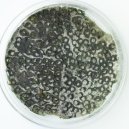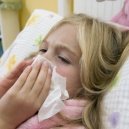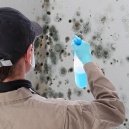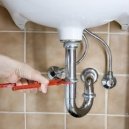Find a pre-screened local mold removal specialist Free Estimate
Find a Mold Specialist Now
Click or Call, Toll-Free 24/7
Mold vs Rust
Can you easily tell the difference between mold vs rust? Many people look at a reddish colored stain and assume its rust, although that’s not always the case. Before you break out your heavy-duty cleaning solutions, it pays to understand what you’re up against: mold, rust, or even another stain.
What’s Normal for Your Home?
If you’re seeing new stains on walls, floors, or countertops, you’ll want to make sure they’re not the result of water infiltration or excess humidity in your home. Try to pinpoint a reason for the stain, based on what room it’s in and the common daily activity. Mold tends to be found in damp, humid areas, while rust forms when metallic surfaces start to corrode. Recognizing the differences between mold and rust helps you determine the best way to take care of an issue before it becomes more pervasive.
What’s that Stain? Mold vs Rust
Areas prone to dampness, such as bathrooms and basements, can easily foster the growth of mold or mildew. If you see a stain that looks like mold or rust in your shower, sink area, or basement, you’ll want to clean them as quickly as possible to avoid permanent damage. However, different cleaning solutions are used to treat different stains. Rust, hard water marks, grease, and mold may all look similar, but if you use the wrong cleaner, you may not be able to fully remove them.
 Mold
Mold Rust
RustIdentifying Rust
Rust is the result of iron, or a metal alloy containing iron, such as steel, corroding. Rust is most often observed as a red, yellow or reddish-brown surface stain. Rust is caused by water or damp air touching the surface or a metal prone to rusting. Some common areas where rust is spotted in the home, according to the International Association of Certified Home Inspectors (InterNACHI), include the following:
- Water Pipes
- Metal Roofs and Chimneys
- Oil tanks for home with oil heat
- Electrical Panel Boxes
- Nails
Preventing Rust
Rust can be prevented by keeping metals out of damp and humid areas. Protective coatings, such as varnish may also be applied to surfaces prone to rusting. Ensuring that metal fixtures in your home are kept dry can also help to prevent rust. Wipe up spills immediately and check your basement after heavy storms to spot signs of flooding as soon as possible.
Removing Rust
Removing rust can be a tough job, but with the right cleaners, you should be successful. For lighter rust stains, some household products, such as baking soda or vinegar might work. Mild abrasives like steel wool pads may also remove surface rust, but they may also leave behind scratch marks. There are also many specialized rust removal products sold that you can try for smaller stains. According to Cleanipedia, one product you should never use on rust is bleach, which could react negatively with the rust and actually worsen it.
If you do attempt to clean rust, always follow the instructions on any commercial cleaning product. Be sure to don safety gear, including gloves, safety glasses and a face mask. Always work in a well-ventilated area. If you’re not comfortable with the task, find a handyman or painter that is.
Mold Stains
Mold can resemble other stains like rust or mildew in appearance, but there are actually over 300 types of mold. The colors of mold can range from black to brown, white or gray, or even pink, blue or green. Mold also presents in a range of textures from downy to fuzzy. Some mold is powdery and some has a more slimy texture.
Mold can grow as the result of a single event, such as a broken pipe or indoor water infiltration due to floods or leaks. It’s important to catch the signs of indoor mold growth as early as possible and have them taken care of before they lead to greater damage. Mold can also adversely affect the health of certain susceptible individuals, including those with a suppressed immune system or an allergy to mold. Mold sometimes can leave a stain, but that’s not always the case. A damp, musty odor can also be a sign of mold growth.
If you notice mold growth in damp areas of your home, you can clean affected surfaces with a specialized mold removal product. Common, everyday household cleaning solutions may not be effective against mold. Typically, mold cannot be totally eradicated from porous surfaces, like shower curtains, drywall or insulation; these items should be disposed of and replaced.
When cleaning mold, you should always wear protective gear, such as a face mask and ensure that you’re working in an adequately ventilated area. You can read more about the protective gear recommended for mold removal. If you suffer from mold allergies or asthma, it is not recommended that you try to clean the mold yourself. A professional mold expert can help you determine the best way to remove the mold. Once the mold is removed, it’s a good idea to have the area tested by a professional. If mold has continued to grow in your home, you may have a more pervasive problem that requires additional professional remediation.
Evaluating Mold Issues
Because so many of the stains we see around the house look similar, it may be difficult to determine what is causing the discoloration and damage. If you notice stains on your walls, countertops, or floors that look like mold or rust, contact a mold expert and request a free home inspection to help diagnose your problem. To find a professional mold specialist in your area, you can complete the contact form and obtain additional information.
Free Home Inspection By A Mold Removal Specialist
Search This Website
 Rust colored mold
Rust colored moldRecent Articles
-
See Our 5 Recommended Mold Removal Companies in Covington, KY
Apr 16, 25 12:59 PM
-
See Our 5 Recommended Mold Removal Companies in Wheaton, IL
Jun 20, 24 10:33 AM
-
See Our 5 Recommended Mold Removal Companies in Aberdeen, SD
Oct 08, 21 04:05 PM




